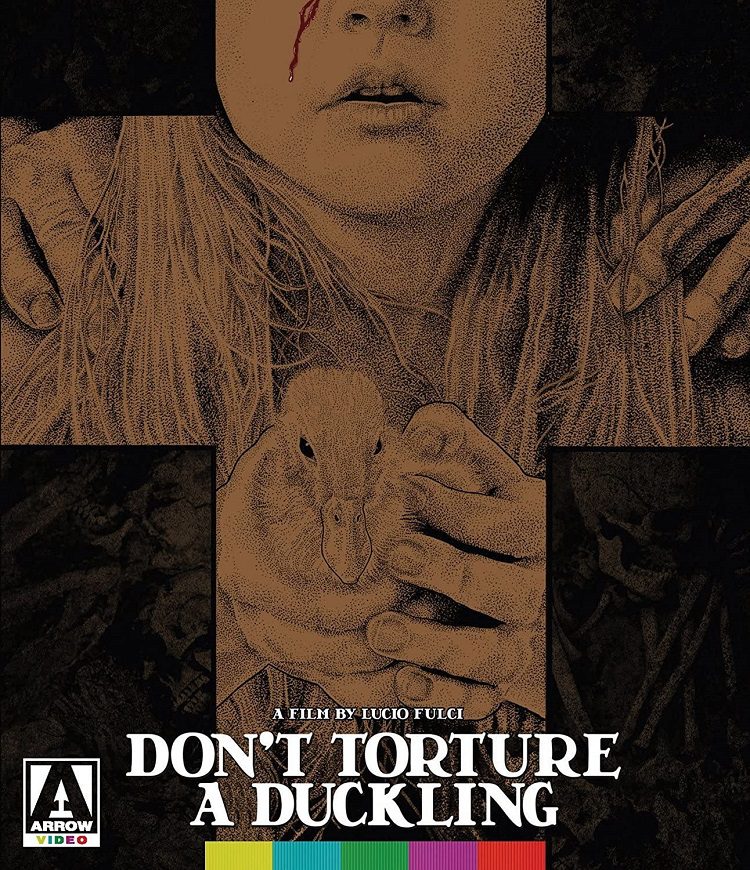
There’s an old saying in Classic Hollywood, attributed to Howard Hawks, that a good movie is “three good scenes, no bad scenes.” Sometimes I’ve felt, while watching Italian horror and Giallo movies, particularly Lucio Fulci’s, that the rule is “three interesting (and gory) scenes, and who the hell cares what else happens?” Shock and strangeness are paramount, with coherence coming a very distant third. So it was surprising to me, watching Don’t Torture a Duckling, that it has a story that can be pieced together with only a few leaps in logic.
Don’t Torture a Duckling begins with a genuinely shocking image – a woman, digging into the dirt, and pulling out the skeleton of a deformed child, with a crack in its skull. Then we follow a young Italian boy, taking a break from torturing lizard to watch the highways leading past his small village, until he finds what he’s looking for: a pair of prostitutes that some men from the village had called up. (Apparently, in Italian villages prostitutes deliver, like pizza parlors.) Two other boys join the first, splitting cigarettes and trying their damnedest to seem older than they are.
These three boys, by about halfway through the film, will all be dead, two murdered off screen but with their bodies found in graphic states of decay. Child murder as a cinematic taboo is usually handled with some discretion, but there’s not a lot discrete about Lucio Fulci’s brand of filmmaking. He likes to shock, sometimes in interesting ways, sometimes without a semblance of sense or reason.
It isn’t just gore that shocks in Don’t Torture a Duckling – the undercurrent of pre-adolescent sex is there early on, and then moves from subtext to full on text when a nude woman begins quizzing one of the boys about his sex life. He’s just there helping his mother, who is a maid at this rich woman’s house. The woman, Patrizia (played by the lovely Barbara Bouchet) plays at mock-seducing him. It’s all a game to her, but it’s a decidedly unsettling scene.
Patrizia is eventually one of the suspects for the child serial murderer, along with a healthy collection of other potentials: there’s the village idiot, whom the children mock for trying to watch the prostitutes get it on with their johns. There’s the local witch, who digs up the infant’s skeleton at the beginning of the film. There’s the magician, who has taught the witch, and who holds trysts with Patrizia, and who happens to be the local top cop’s uncle. The village priest is the closest person to the children, but his mother seems to be a person of interest, as well.
Duckling is a Giallo film, a particularly Italian style of crime and horror picture, where a serial killer is motivated by psychological or psychosexual desires to commit his heinous, lurid, and usually inventive crimes. Blood and Black Lace directed by Mario Bava is an early and seminal variation on the theme, and it set an early standard for inventive cinematic spaces, attractive though hardly realistic lighting schemes, and tip-toeing on the line between titillation and complete exploitation. Fulci, in what is maybe his most lauded film, eschews the heavy stylization and doesn’t give a damn about lines, of decency or coherence or anything.
Don’t Torture a Duckling nominal protagonist is a journalist, Martelli. He follows the cops around, and eventually does some digging on his own when their investigation roams from suspect to suspect without finding anything concrete. However, the film doesn’t pick and stick with a single subject, preferring to move from points of view as the mood is required. Some scenes are played out objectively, like police procedurals. Others follow the journalist or cops, whoever is convenient for telling the story at the time. It’s not a style I find confusing as much as I think it limits audience involvement – for much of the film one is following events, rather than characters.
Still, they’re often intriguing events, and the story is more coherent in the summarizing than in the watching. The rural setting is unusual for a Giallo, and there are themes about the repression of rural life and tolerance that aren’t just window dressing. Like many Italian horror movies there’s a whole lot more to Duckling in the parts than in the sum.
On one of the many interesting video extras included on the Blu-ray, Giallo scholar Mikel J. Koven gives a fascinating overview of how movies like Duckling were exhibited – largely in third-tier theaters with a rural or lower class audience, who were as interested in socializing as in watching what’s on screen. So, to get the audience’s attention, it would take an occasional infant corpse, beautiful nude woman coming on to a 10-year old, or a body being ripped apart by chain to get the audience to look at the screen. It isn’t the best thing to watch alone in a room on a TV… though it sure as hell beats the modern horror movie aesthetic, where every seven minutes a loud noise reminds people to look up from their phones and scream.
Don’t Torture a Duckling is an Arrow video release, on DVD and Blu-ray, and is packed with extras. Besides the discussion by Mikel Koven, there’s another video essay by critic Kat Ellinger, a long audio interview by Fulci from 1988, and nearly two hours of interviews with surviving crew and cast members about what it was like to work with Fulci. There’s also an academic (meant as a compliment) feature-length audio commentary by another Giallo expert, Troy Howarth, and a two essays in the liner booklet: one about Duckling by Barry Forshaw, and another about the composer Riz Ortolani by Italian film expert Howard Hughes.